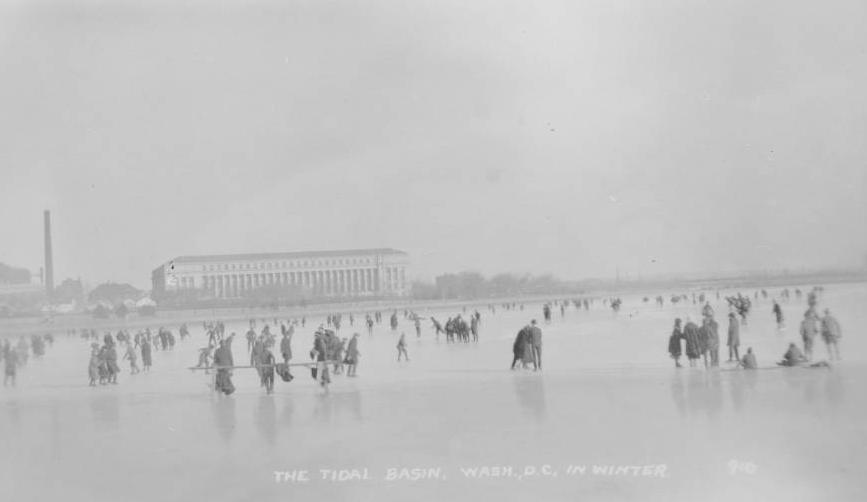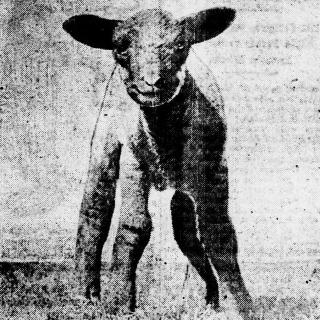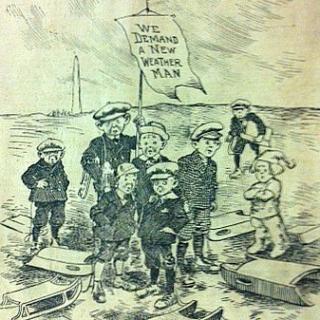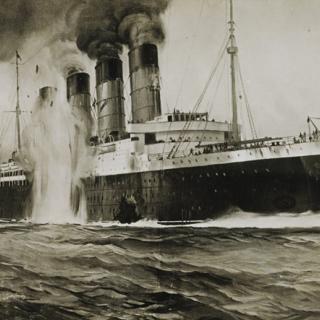Ice Carnival at the Tidal Basin
We’ve written earlier about how the Tidal Basin was the site of a popular public beach in the 1920s. In the decade before, however, it hosted another source of popular entertainment: ice skating. In 1912, it was the site of an elaborate “ice carnival,” with thousands of Washingtonians showing up for an evening full of wintery fun including skating and sledding.
In the 1900s, the Tidal Basin freezing was a rare treat. Unlike the Potomac River, when the enormous basin froze completely, it had a smooth surface, turning it into a gigantic potential ice rink. The absolutely frigid temperatures of the winter of 1912 gave D.C. residents ample chance to take advantage of this. For several weeks in January and February 1912, D.C. was subject to “the coldest temperatures of the 20th century.” It was a cold spell that could put a polar vortex to shame. On January 14, 1912, the low was -13 degrees Fahrenheit, a temperature that has never again been reached in the District, and which is rivaled only by one freezing day in 1899.[1] Pipes burst, gas meters iced over, and milk bottles froze, with “the cream [swelling] out into a solid cylinder two inches above the mouths of the bottles.”[2]
Obviously, people were pretty miserable. But the upside of this was that for several weeks, the Tidal Basin was completely frozen, creating perfect skating conditions. Many people had already ventured out onto the ice on their own, but some District officials had bigger plans.[3]
The day after that frigid low, January 15, it was floated to the press that an “ice carnival” was being planned for the following Wednesday, January 17. A committee had already been assembled to clear snow off the ice for skaters, and they had hit upon the idea to organize a big skating event, since conditions were so favorable. (Because this is Washington, the snow-clearing committee included the Secretary of the Navy, a prominent member of the Treasury Department, the First Assistant Postmaster General, and a French Viscountess, among others.)[3]
“Ice carnivals” had been gaining popularity further North over the past twenty to thirty years; Montreal’s famous ice carnival had been a success since the 1880s. In 1895, in imitation of these trends, the Light Infantry First Battalion even put on an indoor ball at the Armory that they alternately called an “ice carnival” or “An Evening in Iceland.”[4] As the Washington Post put it, however, an ice carnival like this “never ha[d] been seen in the cities of the South.”[5]
In the days beforehand, a bandstand was built on the ice, and lights were hung to illuminate the surface of the frozen reservoir. Grandiose plans for a “snow palace” made from the snow cleared off the Basin, with “an archway of snow in which lights could be hung,”[3] were discussed, and there was a general air of great public anticipation.[6]
On the 17th, the officials cleared the snow from an area of the Basin that they deemed large enough to accommodate the skaters, and waited for people to arrive, as scheduled, at 7:30. The organizers expected a turnout of a few thousand, as large as the largest skating crowd that had ever showed up at the Potomac, but instead, as many as 15,000 people arrived at the scene, ready to skate.[7] The police, rightfully nervous that a disaster (an icebreaker?) might occur, limited the skaters to three thousand on the ice at one time. Similarly, when the Marine Band first set up on the bandstand on ice, hundreds of people gathered around them, forcing the planning committee to relocate the band to shore, so that there wouldn’t be so many people weighing down one small area of the frozen Basin. The upshot of this was that only about a third of those who turned up managed to get on the ice. (As if to rub it in, the Washington Post pointed out that “None of the people on the banks, however, had half as much fun as those actually on skates.”)[8] The officials’ caution paid off, however; remarkably, even though there were thousands of people skating near dark on natural ice and thousands more clustered on the banks, there were no accidents.[8]
Despite the prohibitively large turnout, the event was an enormous success. No snow palace was built, but the park and reservoir that night would have been an astonishing and delightful sight nevertheless. Thousands showed up to skate, men and women, old and young, many in fancy dress or in “fantastic costumes.”[7] Some came masked, as was carnival tradition.[7]Members of high society, politicians, ambassadors from icier countries, and the general public skated accompanied by the music of a section of the Marine Band. It was a colorful scene, with “strings of electric lights,” “long lines of varicolored Japanese lanterns,”[7] and “bonfires”[5] along the banks illuminating the Basin. Skaters zipped across the ice carrying lanterns and colored lights sold to them by vendors on the side of the Basin; to those watching on the shore, it must have looked like the biggest and brightest cloud of fireflies they’d ever seen.[8]
The Post described the evening as “a festival worthy of nations where king winter reigns supreme.”[7] Based on the enormous public interest in the “ice carnival,” plans began to be made for an ice rink to be built on land, so Washingtonians wouldn’t have to depend on the vagaries of the weather in order to skate.[9]
This wasn’t the last time that Washingtonians skated on the Basin. People continued to skate for as long as the Basin was frozen, which was another few weeks; there were even reports of people playing baseball on the ice that February.[10] In years to come, ice skating continued at the Tidal Basin, whenever it was frozen over, for at least the next few decades.
This wasn’t D.C.’s last “ice carnival,” either. The event was repeated two years later, in 1914, to similar success.[11] In 1925, one took place on the Lincoln Memorial reflecting pools, which featured races and the apparently ever-popular “baseball game on ice.”[12] In the early 1940s, Riverside Stadium[13] played host to several “ice carnivals,” which had by that time come to mean spectator events showcasing skating skills. At one of these events, U.S. champion skaters put on a show to benefit a charity for the blind.[14]
Of course, D.C. residents can still skate today at the National Gallery of Art, as well as several other outdoor skating rinks in the District. Still, the time when the Tidal Basin was a viable ice rink is long past. The Basin froze as recently as last winter, in the recurral of the aforementioned polar vortex, but ice skating is no longer permitted. On the Tidal Basin, at least, the “ice carnival” is a thing of the past.
Sidenote to this story: basically every single ice carnival, as well as the ice rink, was spearheaded by Treasury Department official and apparent ice skating fanatic E.C. Meyers, about whom I can discover nothing except his love for winter sports.
Footnotes
- ^ Ian Livingston, “Putting cold temperatures in perspective in D.C.,” Washington Post, January 23, 2013.
- ^ “Not Quite So Cold: About Five Above Is Weather Promise For Tonight,” Evening Star, January 15, 1912, p. 1.
- a, b, c “Big Carnival on Ice: Secretary Meyer and Other Society People Interested,” Washington Post, January 15, 1912, p. 1.
- ^ The event was a hugely elaborate affair: “In one corner of the hall are three Esquimo [sic] huts, while behind them glow the northern lights. In another corner a truly picturesque waterfall; real, wet water. A large palace had been built on either side of the hall, where the half-frozen pedestrians may stop for something warm. In their backgrounds are high and mighty icebergs. In several places huge polar bears peep around the corner of an icicle...A real pine forest, snow-sprinkled and with birds, makes another attraction.” [“DOINGS OF THE MILITIA: Enforcing Gen, Ordway’s Orders Governing New Armory,” Washington Post, March 16, 1895.]
- a, b “Ready for Ice Fete: Skaters to Honor King Winter Tonight at Tidal Basin,” Washington Post, January 17, 1912, p. 1.
- ^ Ice carnival hype was at such a high that the Evening Star joked about it with regards to astronomy: “Having observed frost on Mars, Prof. Lowell should look more closely to see if he cannot discover an ice carnival.” [Evening Star, January 17, 1912, p. 6.]
- a, b, c, d, e “15,000 at Carnival: Tidal Basin Is Thronged for Great Fete on Ice,” Washington Post, January 18, 1912, p. 1.
- a, b, c “15,000 at Carnival,” Washington Post, p. 2.
- ^ “Plan Indoor Rink For Ice Skaters,” Washington Herald, March 3, 1912.
- ^ Reportedly, the Artists beat the Doctors 14 to 3. It’s unclear if this was actually a case of two professions squaring off against each other, or simply the lamest team names of all time. [“Warmer Weather, Beginning Tonight, Promised to City: Predicted That Lowest Temperature Will Be About Twenty Degrees,” Washington Times, February 7, 1912.]
- ^ “Ice Carnival Tonight: Weather Alone May Prevent Merry Revel on Tidal Basin,” Washington Post, December 29, 1914. There was a similar ice baseball game planned, this time to be Congressmen against civilians, but “affairs of state” got in the way and the game was cancelled - which just goes to show you that even then, Congress would never miss a chance to let down the American public.
- ^ “Ice Carnival Tonight: Weather Alone May Prevent Merry Revel on Tidal Basin,” Washington Post, December 29, 1914. There was a similar ice baseball game planned, this time to be Congressmen against civilians, but “affairs of state” got in the way and the game was cancelled - which just goes to show you that even then, Congress would never miss a chance to let down the American public.
- ^ Riverside Stadium was a roller rink and sporting arena from 1938-1952. It was on the current site of the Kennedy Center.
- ^ “Skating Stars Offered in Ice Carnival: Washington Holds Own Show at Riverside Stadium as Benefit,” Washington Post, March 17, 1940.






![Sketch of the mythical fuan by Pearson Scott Foresman. [Source: Wikipedia]](/sites/default/files/styles/crop_320x320/public/2023-10/Goatman_Wikipedia_Faun_2_%28PSF%29.png?h=64a074ff&itok=C9Qh-PE1)












